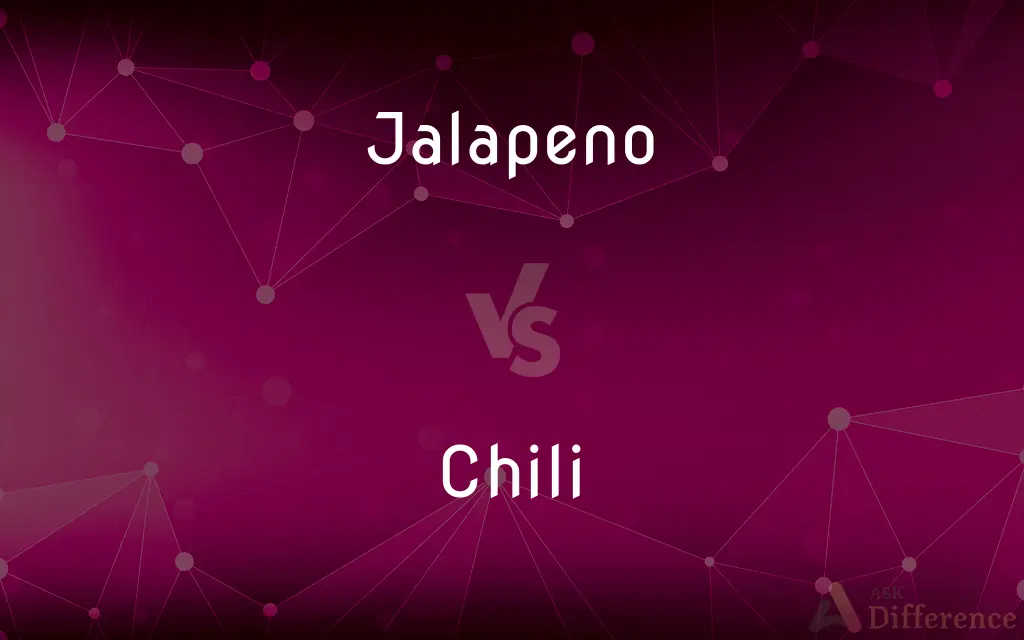Jalapeno vs. Chili — What's the Difference?
Edited by Tayyaba Rehman — By Maham Liaqat — Updated on March 26, 2024
Jalapeno is a medium-sized chili pepper with a mild to moderate heat level, while "chili" refers to a wide variety of peppers with varying heat levels.

Difference Between Jalapeno and Chili
Table of Contents
ADVERTISEMENT
Key Differences
Jalapeno peppers are a specific type of chili pepper known for their distinctive, moderate heat and are widely used in Mexican and Tex-Mex cuisines. They are typically picked and consumed while green, although they can turn red and become sweeter as they mature. Jalapenos have a Scoville heat unit (SHU) range of 2,500 to 8,000, making them relatively mild to moderate in terms of spiciness. On the other hand, the term "chili" encompasses a broad spectrum of chili peppers, ranging from the very mild bell peppers to the extremely hot Carolina Reaper. Chili peppers vary significantly in size, color, flavor, and heat level, influenced by their species and cultivation conditions. Their SHU can range from zero for bell peppers to over 2 million for the hottest peppers like the Carolina Reaper.
While jalapenos are commonly used fresh, sliced, or diced in dishes to add a noticeable but not overwhelming heat, chili peppers, depending on their variety, can be used in a wide range of culinary applications. Some are favored for their intense heat, while others are chosen for their unique flavors and aromas, which can significantly influence the overall profile of a dish.
Both jalapenos and other types of chili peppers are rich in vitamins and minerals, including vitamin C and A, although the nutritional content can vary slightly depending on the specific type of chili. Additionally, capsaicin, the compound responsible for the spicy heat of chili peppers, has been noted for its health benefits, including pain relief and improving heart health.
In culinary use, jalapenos are often seen in salsas, dips, and as toppings for foods like nachos and pizzas. In contrast, chili peppers can be used in a wider variety of ways, including in powders, sauces, and as key ingredients in spicy dishes from various global cuisines. The choice between jalapenos and other chili peppers often depends on the desired heat level and specific flavor profile sought in cooking.
Comparison Chart
Type
Specific type of chili pepper.
Broad category of peppers.
ADVERTISEMENT
Heat Level
Mild to moderate (2,500-8,000 SHU).
Varies widely (0 to over 2 million SHU).
Common Uses
Fresh, in salsas, dips, toppings.
Powders, sauces, dishes of various cuisines.
Flavor
Crisp, bright, slightly sweet when mature.
Ranges from sweet to extremely spicy.
Nutritional Content
Rich in vitamins C and A, capsaicin.
Varies, generally rich in vitamins, capsaicin.
Compare with Definitions
Jalapeno
Contains capsaicin, which provides its moderate spiciness.
The capsaicin in jalapenos can boost metabolism.
Chili
Refers to a wide variety of spicy peppers from the Capsicum family.
He grows several types of chili in his garden, from mild to extremely hot.
Jalapeno
Cultivated mostly in Mexico, it is green when harvested and turns red upon maturing.
The red jalapenos are sweeter and great for making sauces.
Chili
Can be fresh, dried, powdered, or turned into sauces.
Homemade chili sauce adds a fiery depth to recipes.
Jalapeno
Has a distinctive, crisp flavor that complements many dishes.
Jalapeno poppers are a popular appetizer in Tex-Mex cuisine.
Chili
Used globally in different cuisines to add heat and flavor to dishes.
Chili powder is a staple spice in Indian curries.
Jalapeno
Often eaten raw, cooked, or pickled in various culinary applications.
Pickled jalapenos add a tangy, spicy flavor to sandwiches.
Chili
The heat is measured in Scoville heat units (SHU).
The Scoville scale helps cooks choose the right chili for their dish.
Jalapeno
A medium-sized chili pepper with mild to moderate heat, used widely in cuisine.
She added sliced jalapenos to the nachos for a spicy kick.
Chili
Includes varieties that vary greatly in size, color, and heat level.
From tiny bird's eye chili to large bell peppers, the diversity is amazing.
Jalapeno
A cultivar of the tropical pepper Capsicum annuum having a very pungent green or red fruit.
Chili
The pungent fresh or dried fruit of any of several cultivated varieties of capsicum, used especially as a flavoring in cooking. Also called chili pepper.
Jalapeno
The fruit of this plant.
Chili
A stew made of meat or beans (or both) and usually tomatoes, spiced with chili peppers or chili powder.
Jalapeno
Alternative spelling of jalapeño
Chili
(countable) The pungent, spicy fresh or dried fruit of any of several cultivated varieties of capsicum peppers, used in cooking.
Chili pepper
Jalapeno
Plant bearing very hot and finely tapering long peppers; usually red
Chili
(uncountable) Powdered chili pepper, used as a spice or flavouring in cooking.
Chili powder
Jalapeno
Hot green or red pepper of southwestern United States and Mexico
Chili
(Indian Chinese cuisine) A spicy stew of chicken or paneer, capsicum and onion, eaten as an appetizer.
Chili
A dish made with chili peppers and other ingredients, such as beans and beef.
Chili con carne
Chili
(Cincinnati) Cincinnati chili.
Chili
A kind of red pepper. See Capsicum
Chili
Ground beef and chili peppers or chili powder often with tomatoes and kidney beans
Chili
Very hot and finely tapering pepper of special pungency
Common Curiosities
How do I reduce the heat of chili peppers in dishes?
Removing the seeds and membranes can reduce the heat, as can pairing the dish with dairy products like sour cream or yogurt.
Are jalapenos always green?
Jalapenos are typically harvested and consumed when green, but they can turn red and become sweeter as they mature.
What makes jalapenos different from other chili peppers?
Jalapenos are a specific type of chili pepper with a moderate heat level and distinctive flavor, whereas "chili" can refer to any pepper in the Capsicum family with varying heat levels.
What's a good starting point for someone new to spicy foods?
Starting with milder chili peppers like jalapenos or bell peppers can help build tolerance to spicier foods.
Are dried chili peppers hotter than fresh ones?
Drying can concentrate the flavors and heat, making some dried chilies seem hotter than their fresh counterparts.
Is eating chili peppers healthy?
Yes, chili peppers are rich in vitamins and capsaicin, which has various health benefits, including pain relief and potentially improving heart health.
Is there a way to cool my mouth down quickly after eating a very hot chili?
Drinking milk, eating yogurt, or consuming other dairy products can help neutralize the burning sensation because casein, a protein found in dairy, binds with capsaicin and helps wash it away.
Can all chili peppers be used the same way in cooking?
While many chili peppers can be used interchangeably, their heat level and flavor profile should be considered to achieve the desired taste in dishes.
Can I substitute jalapenos for other chili peppers in recipes?
Yes, but consider the heat level and flavor profile of the substitute to maintain the desired outcome of the dish.
What is the hottest type of chili pepper?
As of my last update, the Carolina Reaper holds the record for the hottest chili pepper.
How can I tell if a jalapeno will be on the milder or hotter end of its heat range?
The presence of white "stretch marks" or striations on the jalapeno's surface can indicate a hotter pepper, as these marks often signify that the pepper has experienced stress, which can increase capsaicin production.
Can I grow jalapenos and other chili peppers at home?
Yes, both jalapenos and many other chili peppers can be grown at home in gardens or containers. They require plenty of sunlight, warm temperatures, and well-drained soil to thrive. Starting seeds indoors can give them a head start in cooler climates.
Do all chili peppers turn red when they mature?
Many chili peppers turn red upon reaching maturity, but some varieties can turn yellow, orange, purple, or even brown, depending on the specific type of chili.
Why are chili peppers used so widely in hot climates?
Historically, chili peppers have been used in hot climates for their antibacterial properties, which can help preserve food, and also because the sweating caused by eating spicy food can help cool the body down through evaporation.
Share Your Discovery

Previous Comparison
Vaishnavism vs. Shaivism
Next Comparison
Power vs. LeadershipAuthor Spotlight
Written by
Maham LiaqatEdited by
Tayyaba RehmanTayyaba Rehman is a distinguished writer, currently serving as a primary contributor to askdifference.com. As a researcher in semantics and etymology, Tayyaba's passion for the complexity of languages and their distinctions has found a perfect home on the platform. Tayyaba delves into the intricacies of language, distinguishing between commonly confused words and phrases, thereby providing clarity for readers worldwide.















































